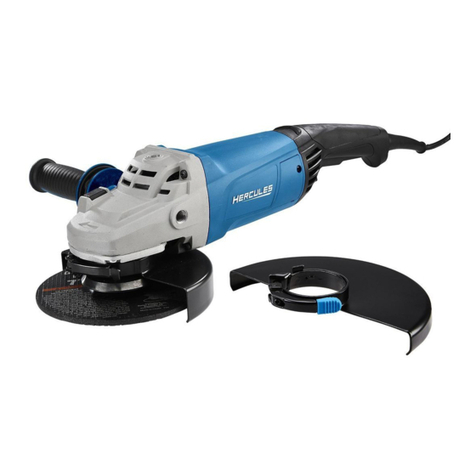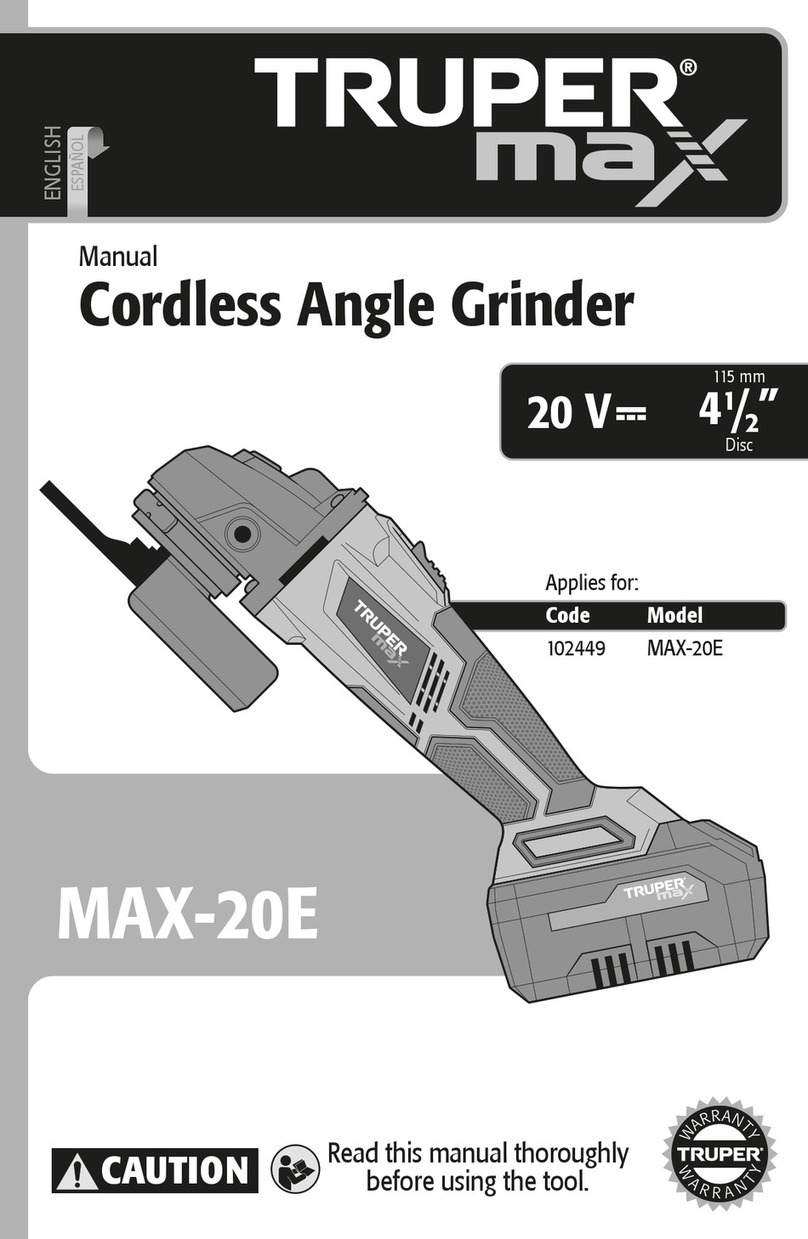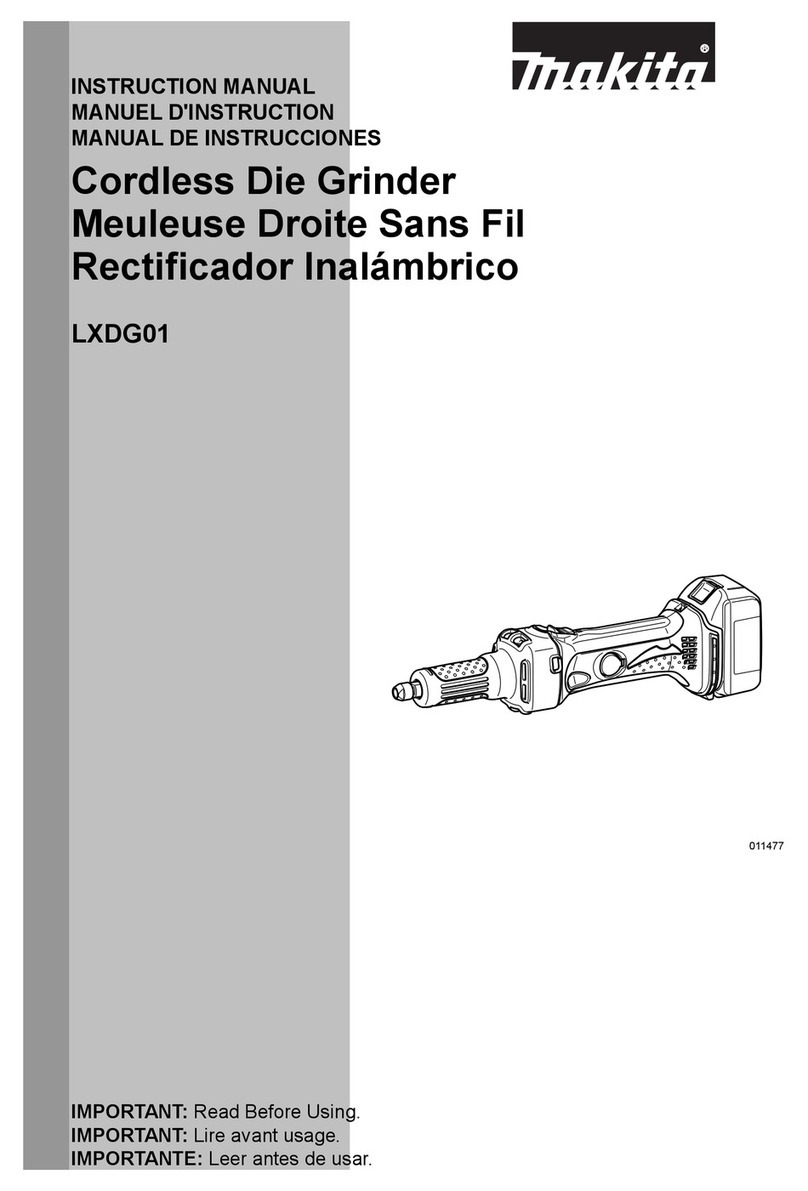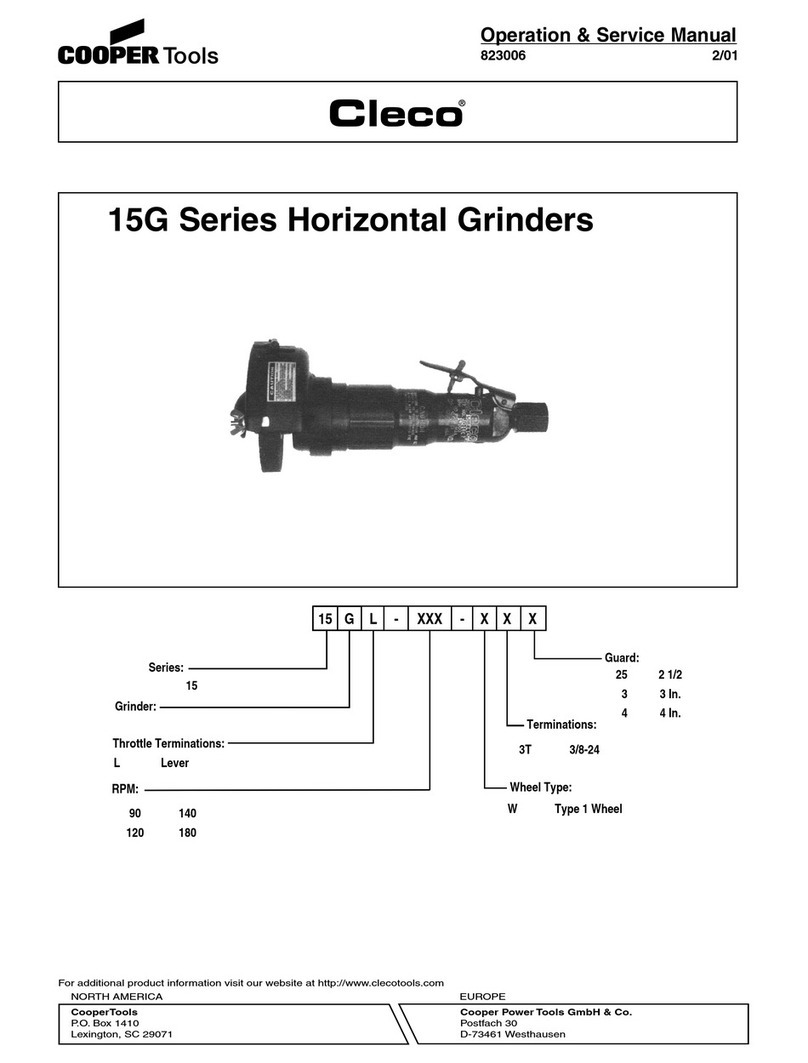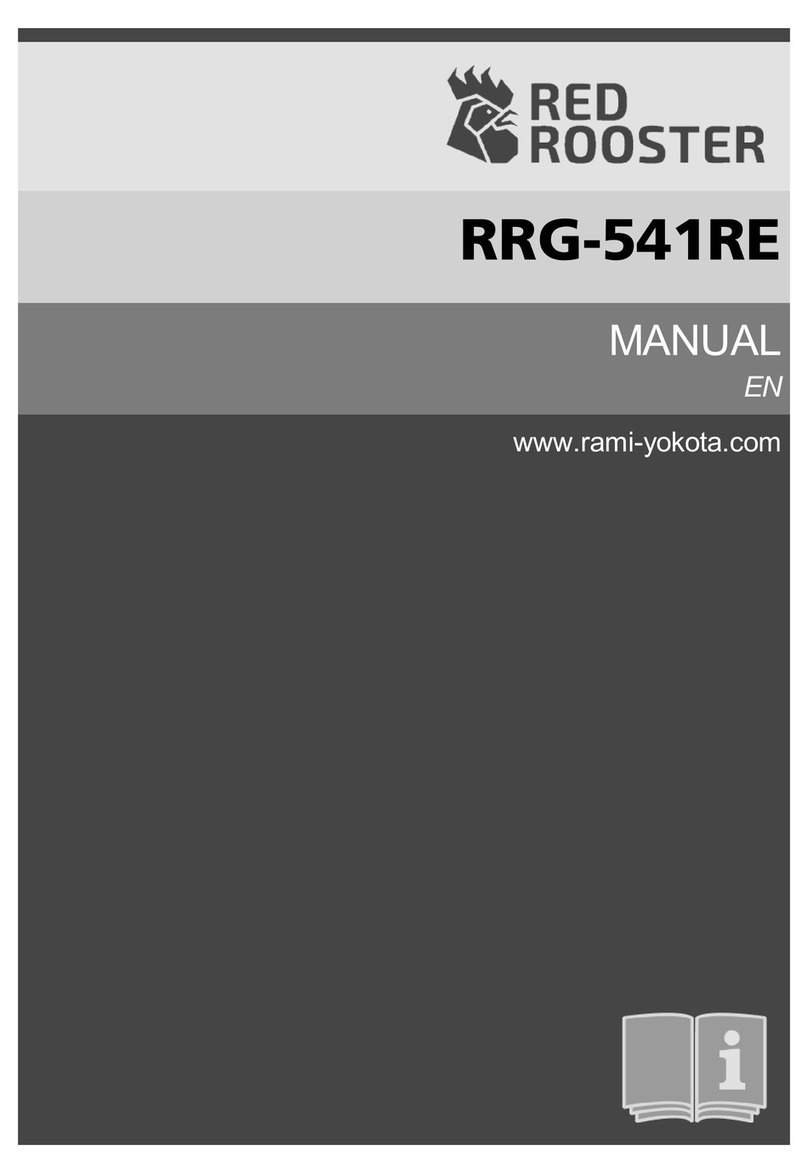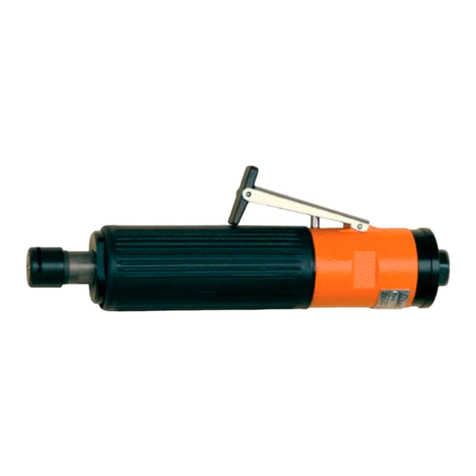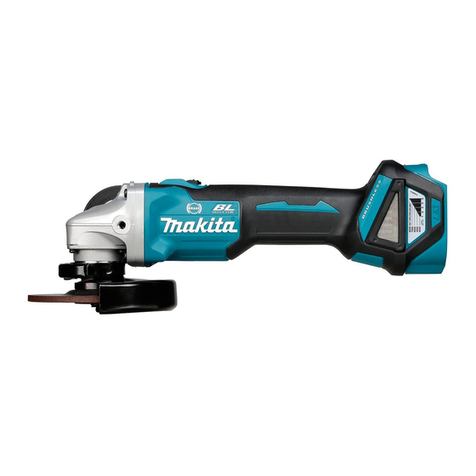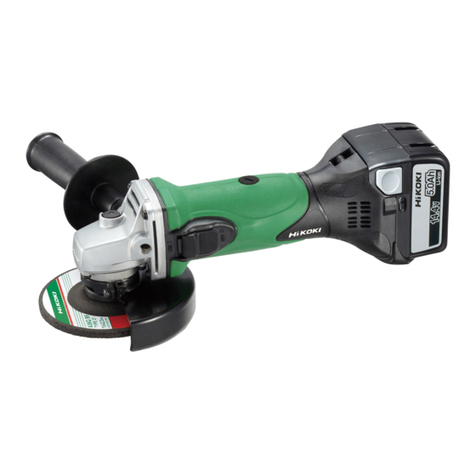Hercules HE093 User manual

8″ 8 Amp Professional Bench Grinder
Model
HE093
WARNING: To prevent serious injury, User must read and
understand Owner’s Manual. SAVE THIS MANUAL.
When unpacking, make sure that the product is intact and undamaged.
If any parts are missing or broken, please call 1-888-866-5797
as soon as possible. Reference 70557.
Owner’s Manual &
Safety Instructions
22k

Page 2 For technical questions, please call 1-888-866-5797. Item 70557
IMPORTANT SAFETY INFORMATION
General Power Tool Safety Warnings
Read all safety warnings, instructions, illustrations
and specifications provided with this power tool.
Failure to follow all instructions listed below may
result in electric shock, fire and/or serious injury.
Save all warnings and instructions
for future reference.
The term “power tool” in the warnings refers
to your mains-operated (corded) power tool
or battery-operated (cordless) power tool.
Work Area Safety
1. Keep work area clean and well lit.
Cluttered or dark areas invite accidents.
2. Do not operate power tools in explosive
atmospheres, such as in the presence of
flammable liquids, gases or dust. Power tools
create sparks which may ignite the dust or fumes.
3. Keep children and bystanders away
while operating a power tool. Distractions
can cause you to lose control.
Electrical Safety
1. Power tool plugs must match the outlet.
Never modify the plug in any way. Do not use
any adapter plugs with earthed (grounded)
power tools. Unmodified plugs and matching
outlets will reduce risk of electric shock.
2. Avoid body contact with earthed or grounded
surfaces, such as pipes, radiators, ranges
and refrigerators. There is an increased risk of
electric shock if your body is earthed or grounded.
3. Do not expose power tools to rain or wet
conditions. Water entering a power tool
will increase the risk of electric shock.
4. Do not abuse the cord. Never use the cord
for carrying, pulling or unplugging the power
tool. Keep cord away from heat, oil, sharp
edges or moving parts. Damaged or entangled
cords increase the risk of electric shock.
5. When operating a power tool outdoors,
use an extension cord suitable for outdoor
use. Use of a cord suitable for outdoor
use reduces the risk of electric shock.
6. If operating a power tool in a damp location
is unavoidable, use a ground fault circuit
interrupter (GFCI) protected supply. Use of
a GFCI reduces the risk of electric shock.
Personal Safety
1. Stay alert, watch what you are doing and use
common sense when operating a power tool. Do
not use a power tool while you are tired or under
the influence of drugs, alcohol or medication.
A moment of inattention while operating power
tools may result in serious personal injury.
2. Use personal protective equipment. Always
wear eye protection. Protective equipment
such as dust mask, non-skid safety shoes, hard
hat, or hearing protection used for appropriate
conditions will reduce personal injuries.
3. Prevent unintentional starting. Ensure the
switch is in the off-position before connecting
to power source and/or battery pack, picking
up or carrying the tool. Carrying power tools
with your finger on the switch or energizing power
tools that have the switch on invites accidents.
4. Remove any adjusting key or wrench
before turning the power tool on. A wrench
or a key left attached to a rotating part of the
power tool may result in personal injury.
5. Do not overreach. Keep proper footing and
balance at all times. This enables better control
of the power tool in unexpected situations.
6. Dress properly. Do not wear loose clothing or
jewelry. Keep your hair, clothing and gloves
away from moving parts. Loose clothes, jewelry
or long hair can be caught in moving parts.
7. If devices are provided for the connection of
dust extraction and collection facilities, ensure
these are connected and properly used. Use of
dust collection can reduce dust-related hazards.
8. Do not let familiarity gained from frequent use
of tools allow you to become complacent and
ignore tool safety principles. A careless action
can cause severe injury within a fraction of a second.
9. Only use safety equipment that has been
approved by an appropriate standards agency.
Unapproved safety equipment may not provide
adequate protection. Eye protection must be
ANSI-approved and breathing protection
must be NIOSH-approved for the
specific hazards in the work area.
10. Avoid unintentional starting.
Prepare to begin work before turning on the tool.
11. Do not leave the tool unattended when it is
plugged into an electrical outlet. Turn off the tool,
and unplug it from its electrical outlet before leaving.
12. This product is not a toy.
Keep it out of reach of children.

Page 3For technical questions, please call 1-888-866-5797.Item 70557
13. People with pacemakers should consult their
physician(s) before use. Electromagnetic fields
in close proximity to heart pacemaker could cause
pacemaker interference or pacemaker failure.
In addition, people with pacemakers should:
• Avoid operating alone.
• Do not use with Switch locked on.
• Properly maintain and inspect to avoid
electrical shock.
• Properly ground power cord.
Ground Fault Circuit Interrupter (GFCI)
should also be implemented – it prevents
sustained electrical shock.
14. The warnings, precautions, and instructions
discussed in this instruction manual cannot
cover all possible conditions and situations
that may occur. It must be understood by the
operator that common sense and caution are
factors which cannot be built into this product,
but must be supplied by the operator.
Power Tool Use and Care
1. Do not force the power tool. Use the correct
power tool for your application. The correct
power tool will do the job better and safer
at the rate for which it was designed.
2. Do not use the power tool if the switch
does not turn it on and off. Any power
tool that cannot be controlled with the switch
is dangerous and must be repaired.
3. Disconnect the plug from the power source and/
or remove the battery pack, if detachable, from
the power tool before making any adjustments,
changing accessories, or storing power
tools. Such preventive safety measures reduce
the risk of starting the power tool accidentally.
4. Store idle power tools out of the reach of
children and do not allow persons unfamiliar
with the power tool or these instructions
to operate the power tool. Power tools are
dangerous in the hands of untrained users.
5. Maintain power tools and accessories.
Check for misalignment or binding of moving
parts, breakage of parts and any other
condition that may affect the power tool’s
operation. If damaged, have the power tool
repaired before use. Many accidents are
caused by poorly maintained power tools.
6. Keep cutting tools sharp and clean. Properly
maintained cutting tools with sharp cutting edges
are less likely to bind and are easier to control.
7. Use the power tool, accessories and tool bits
etc. in accordance with these instructions,
taking into account the working conditions
and the work to be performed. Use of the
power tool for operations different from those
intended could result in a hazardous situation.
8. Keep handles and grasping surfaces dry, clean
and free from oil and grease. Slippery handles
and grasping surfaces do not allow for safe handling
and control of the tool in unexpected situations.
Service
1. Have your power tool serviced by a
qualified repair person using only identical
replacement parts. This will ensure that the
safety of the power tool is maintained.
2. Maintain labels and nameplates on the tool.
These carry important safety information.
If unreadable or missing, contact
Harbor Freight Tools for a replacement.
Bench Grinder Safety Warnings
1. Do not use a damaged accessory. Before
each use, inspect the accessory such as
abrasive wheels for chips and cracks (keep
the following only for tools that can use wire
brushes) and wire brushes for loose or cracked
wires. After inspecting and installing an
accessory, position yourself and bystanders
away from the plane of the rotating accessory
and run the power tool at maximum no-load
speed for one minute. Damaged accessories
will normally break apart during this test time.
2. The rated speed of the accessory must be at
least equal to the maximum speed marked
on the power tool. Accessories running faster
than their rated speed can break and fly apart.
3. (For tools that can use wire brushes.) Be
aware that wire bristles are thrown by the wire
brush even during ordinary operation. Do not
overstress the wires by applying excessive
load to the wire brush. The wire bristles can
easily penetrate light clothing and/or skin.
4. Never grind on the sides of a grinding
wheel. Grinding on the side can cause
the wheel to break and fly apart.

Page 4 For technical questions, please call 1-888-866-5797. Item 70557
Vibration Safety
This tool vibrates during use.
Repeated or long-term exposure to vibration may
cause temporary or permanent physical injury,
particularly to the hands, arms and shoulders.
To reduce the risk of vibration-related injury:
1. Anyone using vibrating tools regularly or for an
extended period should first be examined by a
doctor and then have regular medical check-ups
to ensure medical problems are not being caused
or worsened from use. Pregnant women or people
who have impaired blood circulation to the hand, past
hand injuries, nervous system disorders, diabetes,
or Raynaud’s Disease should not use this tool.
If you feel any symptoms related to vibration (such
as tingling, numbness, and white or blue fingers),
seek medical advice as soon as possible.
2. Do not smoke during use. Nicotine reduces
the blood supply to the hands and fingers,
increasing the risk of vibration-related injury.
3. Wear suitable gloves to reduce the
vibration effects on the user.
4. Use tools with the lowest vibration
when there is a choice.
5. Include vibration-free periods each day of work.
6. Grip tool as lightly as possible (while still keeping
safe control of it). Let the tool do the work.
7. To reduce vibration, maintain the tool as
explained in this manual. If any abnormal
vibration occurs, stop use immediately.
GROUNDING
TO PREVENT ELECTRIC SHOCK AND
DEATH FROM INCORRECT
GROUNDING WIRE CONNECTION:
Check with a qualified electrician if you
are in doubt as to whether the outlet is properly
grounded. Do not modify the power cord plug
provided with the tool. Never remove the grounding
prong from the plug. Do not use the tool if the
power cord or plug is damaged. If damaged, have it
repaired by a service facility before use. If the plug
will not fit the outlet, have a proper outlet installed
by a qualified electrician.
Grounded Tools: Tools with
Three Prong Plugs
3-Prong Plug and Outlet
1. Tools marked with “Grounding Required” have
a three wire cord and three prong grounding
plug. The plug must be connected to a properly
grounded outlet. If the tool should electrically
malfunction or break down, grounding provides
a low resistance path to carry electricity away
from the user, reducing the risk of electric shock.
(See 3-Prong Plug and Outlet.)
2. The grounding prong in the plug is connected
through the green wire inside the cord to the
grounding system in the tool. The green wire
in the cord must be the only wire connected to
the tool’s grounding system and must never
be attached to an electrically “live” terminal.
(See 3-Prong Plug and Outlet.)
3. The tool must be plugged into an appropriate outlet,
properly installed and grounded in accordance
with all codes and ordinances. The plug and outlet
should look like those in the preceding illustration.
(See 3-Prong Plug and Outlet.)
Double Insulated Tools: Tools
with Two Prong Plugs
Outlets for 2-Prong Plug
1. Tools marked “Double Insulated” do not
require grounding. They have a special
double insulation system which satisfies
OSHA requirements and complies with
the applicable standards of Underwriters
Laboratories, Inc., the Canadian Standard
Association, and the National Electrical Code.
2. Double insulated tools may be used in either of the
120 volt outlets shown in the preceding illustration.
(See Outlets for 2-Prong Plug.)

Page 5For technical questions, please call 1-888-866-5797.Item 70557
Extension Cords
1. Grounded tools require a three
wire extension cord. Double Insulated tools can
use either a two or three wire extension cord.
2. As the distance from the supply outlet increases,
you must use a heavier gauge extension cord.
Using extension cords with inadequately sized wire
causes a serious drop in voltage, resulting in loss of
power and possible tool damage. (See Table A.)
3. The smaller the gauge number of the wire, the
greater the capacity of the cord. For example,
a 14 gauge cord can carry a higher current
than a 16 gauge cord. (See Table A.)
4. When using more than one extension cord to make
up the total length, make sure each cord contains at
least the minimum wire size required. (See Table A.)
5. If you are using one extension cord for more
than one tool, add the nameplate amperes
and use the sum to determine the required
minimum cord size. (See Table A.)
6. If you are using an extension cord outdoors, make
sure it is marked with the suffix “W-A” (“W” in
Canada) to indicate it is acceptable for outdoor use.
7. Make sure the extension cord is properly wired
and in good electrical condition. Always replace
a damaged extension cord or have it repaired
by a qualified electrician before using it.
8. Protect the extension cords from sharp objects,
excessive heat, and damp or wet areas.
TABLE A: RECOMMENDED MINIMUM WIRE
GAUGE FOR EXTENSION CORDS* (120/240 VOLT)
NAMEPLATE
AMPERES
(at full load)
EXTENSION CORD
LENGTH
25´ 50´ 75´ 100´ 150´
0 – 2.0 18 18 18 18 16
2.1 – 3.4 18 18 18 16 14
3.5 – 5.0 18 18 16 14 12
5.1 – 7.0 18 16 14 12 12
7.1 – 12.0 18 14 12 10 -
12.1 – 16.0 14 12 10 - -
16.1 – 20.0 12 10 - - -
* Based on limiting the line voltage drop to five volts at
150% of the rated amperes.
Warning Symbols and Definitions
This is the safety alert symbol. It is used to
alert you to potential personal injury hazards.
Obey all safety messages that follow this symbol to
avoid possible injury or death.
Indicates a hazardous
situation which, if not
avoided, will result in death or serious injury.
Indicates a hazardous
situation which, if not
avoided, could result in death or serious injury.
Indicates a hazardous
situation which, if not
avoided, could result in minor or moderate injury.
Addresses practices not
related to personal injury.
Symbology
Double Insulated
VVolts
~Alternating Current
AAmperes
n0xxxx/min. No Load Revolutions
per Minute (RPM)
WARNING marking concerning Risk
of Eye Injury. Wear ANSI-approved
safety goggles with side shields.
Read the manual before
set-up and/or use.
WARNING marking
concerning Risk of Fire.
Do not cover ventilation ducts.
Keep flammable objects away.
WARNING marking concerning
Risk of Electric Shock.
Properly connect power cord
to appropriate outlet.

Page 6 For technical questions, please call 1-888-866-5797. Item 70557
Specifications
Electrical Rating 120 VAC / 60 Hz / 8A
No Load Speed n0: 3,580 / min
Min / Max. Accessory Diameter 5-1/2" / 8"
Arbor Size 5/8"
Setup - Before Use:
Read the ENTIRE IMPORTANT
SAFETY INFORMATION section at the
beginning of this manual including
all text under subheadings therein
before set up or use of this product.
Functions
2
4
5
3
1
1. Wheel Cover
2. Eye Shield
3. Tool Rest
4. Power Switch with Safety Key
5. Grinding Wheel
Assembly/Mounting
The two mounting holes in the Base can be used
to attach this Grinder to a stable workbench
using appropriate hardware (sold separately).
Mounting
Holes
1. Install Left Tool Rest (37) to the Left Inner
Wheel Guard (21). Use a Lock Knob (39) and a
Flat Washer (38) to secure it in place. See below.
Left Tool
Rest (37)
Flat
Washer (38)
Lock
Knob (39)
Left Wheel
Guard (21)
2. Repeat step 1 under Assembly/Mounting
on page 6 for installing the Right Tool
Rest (57) onto the Right Inner Wheel
Guard (36). Use a Lock Knob (39) and a
Flat Washer (38) to secure it in place.
3. Adjust the Tool Rests to within 1/16" of the Grinding
Wheels (6). To adjust this distance, loosen Lock
Knobs (39) and move Tool Rests (37/57). Retighten
Lock Knobs to secure Tool Rests in position.
4. Attach Left Spark Guard (13) to Left Inner
Wheel Guard (21) using two Bolts (17) and
Flat Washers (14). See below. Repeat for
installation of the Right Spark Guard (18)
onto the Right Inner Wheel Guard (38).
Left Wheel
Guard (21)
Bolt (17)
Left Spark
Guard (13)
Flat
Washer (14)
5. Adjust each Spark Guard to within 1/16″ of the
Grinding Wheel (6) and tighten the Bolts (17).

Page 7For technical questions, please call 1-888-866-5797.Item 70557
6. Attach Eye Shield (11) to the Left Support (10)
using Screws (9) and Backing Plate (12). See
below. Repeat for installation of the second
Eye Shield (11) to the Right Support (19).
Screw (9)
Left
Support (10)
Eye
Shield (11)
Backing
Plate (12)
7. Attach the Left Support (10) to the Left
Spark Guard (13) using a Lock Knob (16),
Lock Washer (15) and Flat Washer (14). See
below. Repeat for installation of the Right
Support (19) to the Right Spark Guard (18).
Lock
Knob (16)
Flat
Washer (14)
Lock
Washer (15)
Left Spark
Guard (13)
Left
Support (10)

Page 8 For technical questions, please call 1-888-866-5797. Item 70557
OPERATING INSTRUCTIONS
Read the ENTIRE IMPORTANT
SAFETY INFORMATION section at the
beginning of this manual including
all text under subheadings therein
before set up or use of this product.
TO PREVENT SERIOUS INJURY FROM
ACCIDENTAL OPERATION:
Make sure that the Switch is in the off-position
and unplug the tool from its electrical outlet
before performing any procedure in this section.
Tool Changing
Replacing a Grinding Wheel
1. The Grinding Wheel MUST be:
• rated to at least 3,450 RPM.
• no smaller than 5-1/2″ (139.7mm) in diameter
• no larger than 8″ (203.2 mm) in diameter.
• fitted with a 5/8″ round arbor hole.
• 1″ thick.
• suitable for edge grinding, not surface grinding.
• dry and clean.
• proven undamaged by inspection and
by the ring-test explained below.
2. Disconnect the Bench Grinder from the power source.
3. Loosen each Spark Guard and move them
away from the Grinding Wheels.
4. Loosen each Tool Rest and move them
away from the Grinding Wheels.
5. Remove Wheel Cover Screws holding Wheel Covers
to the Bench Grinder. Remove Wheel Covers.
6. Prevent the Grinding Wheel from turning
by holding the opposite Wheel firmly.
7. Remove the Nut from the Grinding Wheel
with a wrench (not included).
a. Turn right side Grinding Wheel Nut
COUNTERCLOCKWISE.
b. Turn left side Grinding Wheel Nut CLOCKWISE.
8. Remove the Outer Flange and Grinding Wheel.
Keep the Inner Flange in position on the Arbor.
Wheel
Covers
Screw
Spark
Guard
Tool Rest
Outer
Flange
Grinding
Wheel
Nut
Inner
Flange
Arbor
9. Closely inspect the new Grinding Wheel
before mounting. Perform a ring-
test on the wheel as follows:
a. Suspend wheel using a dowel or
finger through the Arbor hole.
Tap
Wheel
Here
45°45° 45°45°
45°45° 45°45°
Hang
Wheel
from
Dowel
VV
EE
RR
TT
II
CC
AA
LL
CC
EE
NN
TT
EE
RR
b. Tap the flat side of the wheel with a light non-
metallic object, such as a screwdriver handle,
at a point 45° from the vertical center line on
each side of the wheel and 1 – 2 inches from
the edge of the wheel (see Illustration).
c. Rotate the wheel and repeat the test until
the entire wheel has been checked.
d. An undamaged wheel will give a clear
tone. If cracked, there will be a dead
sound and not a clear ring.

Page 9For technical questions, please call 1-888-866-5797.Item 70557
10. For wheels with paper gaskets (blotters) or
metal gaskets: Slip the wheel onto the Arbor
with the gasket first. The gasket should be
centered on the wheel and the wheel and
gasket should rest flat against the Flange.
WARNING: To prevent serious injury,
gaskets must be used for all grinding
wheels they are provided with. Gaskets
help prevent grinding wheel damage and
wheel slippage, causes of wheel failure.
11. Place the Grinding Wheel with the
Outer Flange onto the Arbor.
12. Thread the Nut onto the Arbor with its flat
side against the Outer Flange. Wrench
tighten only enough so that the Wheel
is securely held on the Arbor.
WARNING: To prevent serious injury, do
not overtighten Nut. Overtightening can
damage the wheel, causing wheel failure.
Correcting Wheel Balance
Confirm Wheel balance by spinning the Wheel by
hand and observing the Wheel distance from the
Tool Rest as it spins; variations in this distance
indicates the Wheel balance needs to be corrected:
1. Loosen Nut, and manually (if possible) adjust
the Wheel closer to the Arbor centerline;
hold in place while tightening the Nut.
2. Use a Wheel Dresser to remove the outermost
layer and / or high spots of the Grinding Wheel
to achieve Wheel balance. Follow the Wheel
Dresser Manufacturer’s instructions.
Note: If Wheel still vibrates excessively after the
Wheel has been dressed or adjusted to center
as described above, and Wheel does not exhibit
wobble from side to side at speed, Wheel is
likely out of balance and should be replaced.
Eliminating Wheel Wobble (Side to Side)
Note: Slight side to side wobble may exist as the
Wheel spins up or down from full speed, but this will
not affect normal operation. Follow the instructions
below to remove excessive side to side wobble:
1. Loosen Nut and rotate Outer Flange slightly.
Snug the Nut and rotate the Wheel by
hand to confirm wobble is eliminated.
2. If Wobble still exists, continue repeating step 1 in
slight increments in the same direction, making sure
Wheel is in the same orientation as it was in step 1.
3. If Wobble is still not eliminated, continue holding
Wheel in same orientation as it was in step
1, and rotate Inner Flange 90o. Repeat Steps
1-2. Continue this sequence of Inner and Outer
Flange movements until Wobble is eliminated.
Note: If necessary, a shim made of paper / card
stock may be placed between the Inner or Outer
Flange and Wheel. If excessive Wobble still
exists, consult Troubleshooting on page 10,
remembering these possible sources of imbalance:
• Wheel is not balanced or is out-of-round.
• Wheel Arbor bushing has excessive play.
• Wheel is of poor quality.
• Inner or Outer Flanges are warped.

Page 10 For technical questions, please call 1-888-866-5797. Item 70557
Workpiece and Work Area Set Up
1. Designate a work area that is clean and well lit.
The work area must not allow access by children
or pets to prevent distraction and injury.
2. Route the power cord along a safe route to reach
the work area without creating a tripping hazard or
exposing the power cord to possible damage. The
power cord must reach the work area with enough
extra length to allow free movement while working.
3. There must not be objects, such as utility lines,
nearby that will present a hazard while working.
4. You must use personal safety equipment including,
but not limited to, ANSI-approved eye and hearing
protection, as well as heavy-duty work gloves.
5. Before beginning work, provide for sparks and
debris that will fly off the work surface.
General Instructions for Use
1. Make sure that the Switch is in the
off-position, then plug in the tool.
2. Adjust the spark arrestor and the work rest frequently
so as to compensate for wear of the wheel.
3. Keep the distance between the spark arrestor/
work rest and the wheel as small as possible and
in any case not greater than 1/16″. Always adjust
the work rest so that the angle between the work
rest and the accessory is always greater than 85°.
WARNING! Replace the worn wheel when
these gaps are no longer able to be maintained.
Also replace damaged or deeply grooved wheels.
4. Always use the tool with accessories on
both spindles in order to limit the risk of
contact with the rotating spindle.
WARNING! Always use the guard, work
rest, transparent screen and spark arrestor
as required for the accessory(ies).
5. Insert the Safety Key and turn the Power Switch on.
6. Allow the tool to come up to full speed
before touching the wheel.
7. Hold the workpiece properly (”using
both hands” if applicable).
8. Apply the workpiece to the wheel,
allowing the tool to operate at full speed.
If the tool bogs down, use lighter pressure.
9. To create a smoother surface,
keep the workpiece moving over the wheel.
10. When finished, turn the Power Switch
off and remove the Safety Key.
WARNING! The tool will restart automatically if stalled.
11. To prevent accidents, turn off the tool and
unplug it after use. Clean, then store the
tool indoors out of children’s reach.

Page 11For technical questions, please call 1-888-866-5797.Item 70557
MAINTENANCE AND
SERVICING INSTRUCTIONS
Procedures not specifically explained
in this manual must be performed
only by a qualified technician.
TO PREVENT SERIOUS INJURY FROM
ACCIDENTAL OPERATION:
Make sure that the Switch is in the off-position
and unplug the tool from its electrical outlet
before performing any procedure in this section.
TO PREVENT SERIOUS INJURY FROM TOOL
FAILURE:
Do not use damaged equipment.
If abnormal noise or vibration occurs, have
the problem corrected before further use.
Cleaning, Maintenance,
and Lubrication
1. BEFORE EACH USE, inspect the general
condition of the tool. Check for:
• loose hardware,
• misalignment or binding of moving parts,
• damaged cord/electrical wiring,
• cracked or broken parts, and
• any other condition that may
affect its safe operation.
2. AFTER USE, wipe external surfaces
of the tool with clean cloth.
3. PERIODICALLY, blow dust and grit out of the
motor vents using dry compressed air. Wear
ANSI-approved safety goggles and NIOSH-
approved breathing protection while doing this.
4. PERIODICALLY, remove the Wheel Covers and
wipe out the wheel chambers with a brush or rag.
Wear ANSI-approved safety goggles and NIOSH-
approved breathing protection while doing this.
5. WARNING! If the plug or the supply cord
of this power tool is damaged, it must be
replaced only by a qualified service technician.
Accessory Storage and Handling
1. Handle accessories carefully to prevent
dropping or bumping. Do not use wheels
that have been dropped or bumped.
2. Store accessories in shelves, racks, boxes, or
drawers. Keep storage area dry and above
freezing. Any grinding wheels exposed to humidity
or freezing temperatures must not be used.

Page 12 For technical questions, please call 1-888-866-5797. Item 70557
Troubleshooting
Problem Possible Causes Likely Solutions
Tool will not start. 1. Cord not connected.
2. No power at outlet.
3. Tool’s thermal reset breaker
tripped (if equipped).
4. Internal damage or wear.
(Carbon brushes or
Switch, for example.)
1. Check that cord is plugged in.
2. Check power at outlet. If outlet is unpowered,
turn off tool and check circuit breaker.
If breaker is tripped, make sure circuit is right
capacity for tool and circuit has no other loads.
3. Turn off tool and allow to cool.
Press reset button on tool.
4. Have technician service tool.
Tool operates slowly. 1. Forcing tool to work too fast.
2. Extension cord too long or cord
diameter too small.
1. Allow tool to work at its own rate.
2. Eliminate use of extension cord. If an extension cord
is needed, use one with the proper diameter for its
length and load. See Extension Cords on page 5.
Excessive noise
or rattling.
Internal damage or wear.
(Bearings, for example.)
Have technician service tool.
Overheating. 1. Forcing tool to work too fast.
2. Blocked motor housing vents.
3. Motor being strained by long or
small diameter extension cord.
1. Allow tool to work at its own rate.
2. Wear ANSI-approved safety goggles and
NIOSH-approved dust mask/respirator while
blowing dust out of motor using compressed air.
3. Eliminate use of extension cord. If an extension cord
is needed, use one with the proper diameter for its
length and load. See Extension Cords on page 5.
Tool does not
grind, sand or
brush effectively.
1. Disc accessory may be
loose on Spindle.
2. Disc accessory may be
damaged, worn or wrong
type for the material.
1. Be sure disc accessory is of correct dimension
and Flange Arbor Nut is tight.
2. Check condition and type of disc accessory. Use only
proper type of disc accessory in good condition.
Grinding Wheels
do not spin true
1. Too much play in the
Grinding Wheel bushings.
2. Inner and / or Outer Flanges are
warped, damaged, or worn.
3. Arbor Nut is too tight.
1. Replace the bushings or install a new Grinding Wheel.
2. Replace Inner and / or Outer Flanges.
3. Loosen Arbor Nut. Do not overtighten.
Excessive Grinding
Wheel vibration
1. Grinding Wheels not balanced.
2. Too much play in the
Grinding Wheel bushings.
3. Inner and / or Outer Flanges are
warped, damaged, or worn.
4. Incorrect type / size Wheel(s).
5. Worn Bearings in Bench Grinder.
1. Balance Grinding wheels and correct side to side
wobble as described in Replacing a Grinding Wheel and
Eliminating Wheel Wobble (Side to Side) on page 9.
2. Replace the bushings or install a new Grinding Wheel.
3. Replace Inner and / or Outer Flanges.
4. Use correct type / size Wheel(s) as described under
Replacing a Grinding Wheel on page 8
5. Have qualified technician replace bearings.
Follow all safety precautions whenever diagnosing or servicing the tool.
Disconnect power supply before service.

Page 13For technical questions, please call 1-888-866-5797.Item 70557
Record Product’s Serial Number Here:
Note: If product has no serial number, record month and year of purchase instead.
Note: Replacement parts may be available for this item.
Visit harborfreight.com/parts for a list of in stock parts. Reference UPC 193175500069.

Page 14 For technical questions, please call 1-888-866-5797. Item 70557
PARTS LIST AND DIAGRAM
Parts List
Part Description Qty
1 Hex Socket Screw M6x25 6
2 Left Wheel Cover 1
3 Star Washer M5 6
4 Nut M16 Left 1
5 Flange 4
6 Grinding Wheel 2
7 Nut M16 Right 1
8 Right Wheel Cover 1
9 Hex Socket Screw M5x10 4
10 Left Eye Shield Support 1
11 Eye Shield 2
12 Backing Plate 2
13 Left Spark Guard 1
14 Flat Washer M6 6
15 Lock Washer M6 2
16 Lock Knob M6x17 2
17 Hex Bolt M6x12 4
18 Right Spark Guard 1
19 Right Eye Shield Support 1
20 Hex Socket Screw M6x18 6
21 Left Wheel Guard 1
22 Hex Socket Screw M6x20 8
23 End Cap 2
24 Wave Spring 1
25 Ball Bearing 2
26 Stator 1
27 Strain Relief Pressure Plate 1
28 Strain Relief Plate 1
29 Hex Socket Screw M4x16 2
30 Power Cord 1
Part Description Qty
31 Hex Socket Screw M5x8 2
32 Power Cord Clip 1
33 Power Cord Mount Plate 1
34 Rotor 1
35 Impeller 1
36 Right Wheel Guard 1
37 Left Tool Rest 1
38 Flat Washer M10 2
39 Lock Knob L Type M10x20 2
40 Hex Socket Screw M5x10 2
41 Power Switch With Safety Key 1
42 Switch Board 1
43 Label 1
44 Power Cord Bushing 1
45 Star Washer M4 1
46 Screw M4x7 1
47 Base 1
48 Hex Bolt M8x20 4
49 Nut With Flange M4 2
50 Capacitor Stand 1
51 Centrifugal Switch 1
52 Capacitor 1
53 Base Plate 1
54 Hex Socket Screw M4x8 4
55 Rubber Foot 4
56 Hex Socket Screw M5x16 4
57 Right Tool Rest 1
58 Flat Washer 1
59 Lock Washer 1
60 Ground Lead 2

Page 15For technical questions, please call 1-888-866-5797.Item 70557
Diagram
1
2
3
4
5
6
5
5
6
5
7
3
8
1
9
10
11
12
1314
1516
1417
1714
161514
18
9
19
11
12
30
29
2827
31
32
33
20
21
23
24
25
26
34
35
25
23
22
36
20
37
38
39
43
44
45
46
47
48
49
50
51
52
53
54
55
56
39
38
57
22
42
41
40
45
46
49
45
58
59
60
60

26677 Agoura Road • Calabasas, CA 91302 • 1-888-866-5797
LIMITED 90 DAY WARRANTY
Harbor Freight Tools Co. makes every effort to assure that its products meet high quality and durability
standards, and warrants to the original purchaser that this product is free from defects in materials
and workmanship for the period of 90 days from the date of purchase. This warranty does not apply to
damage due directly or indirectly, to misuse, abuse, negligence or accidents, repairs or alterations outside
our facilities, criminal activity, improper installation, normal wear and tear, or to lack of maintenance.
We shall in no event be liable for death, injuries to persons or property, or for incidental, contingent,
special or consequential damages arising from the use of our product. Some states do not allow the
exclusion or limitation of incidental or consequential damages, so the above limitation of exclusion
may not apply to you. THIS WARRANTY IS EXPRESSLY IN LIEU OF ALL OTHER WARRANTIES,
EXPRESS OR IMPLIED, INCLUDING THE WARRANTIES OF MERCHANTABILITY AND FITNESS.
To take advantage of this warranty, the product or part must be returned to us with transportation charges
prepaid. Proof of purchase date and an explanation of the complaint must accompany the merchandise.
If our inspection verifies the defect, we will either repair or replace the product at our election or we may
elect to refund the purchase price if we cannot readily and quickly provide you with a replacement. We will
return repaired products at our expense, but if we determine there is no defect, or that the defect resulted
from causes not within the scope of our warranty, then you must bear the cost of returning the product.
This warranty gives you specific legal rights and you may also have other rights which vary from state to state.
Visit our website at: http://www.harborfreight.com
For technical questions, please call 1-888-866-5797
Copyright©2022 by Harbor Freight Tools®. All rights reserved. No portion of this manual or
any artwork contained herein may be reproduced in any shape or form without the express
written consent of Harbor Freight Tools. Diagrams within this manual may not be drawn
proportionally. Due to continuing improvements, actual product may differ slightly from the
product described herein. Tools required for assembly and service may not be included.
Table of contents
Other Hercules Grinder manuals

Hercules
Hercules HA025 Assembly instructions

Hercules
Hercules HA024 Assembly instructions

Hercules
Hercules DS 150/200 User manual
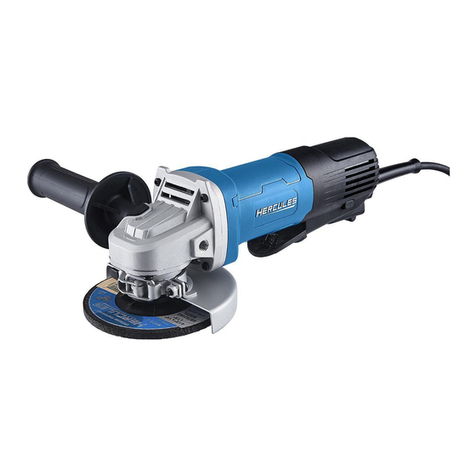
Hercules
Hercules HE61P Assembly instructions
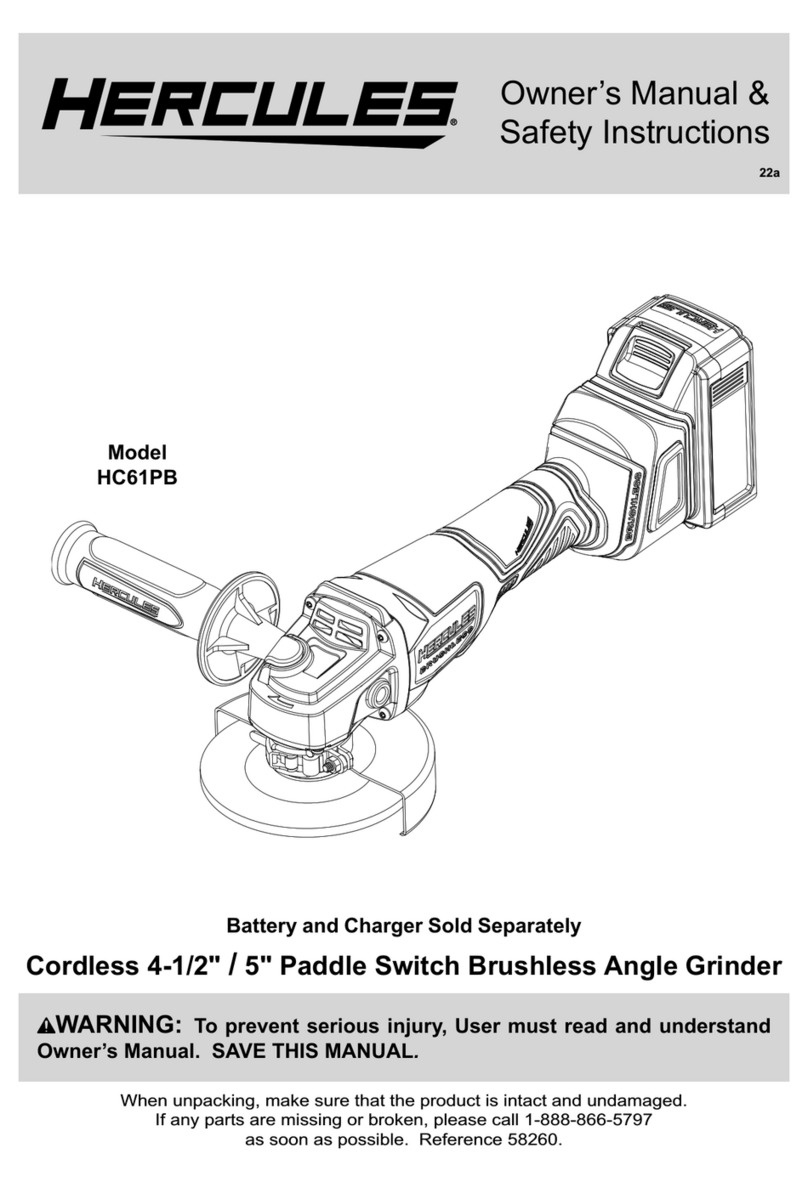
Hercules
Hercules HC61PB Assembly instructions

Hercules
Hercules HC61SB Assembly instructions

Hercules
Hercules HE64 Assembly instructions

Hercules
Hercules HCB64B Assembly instructions
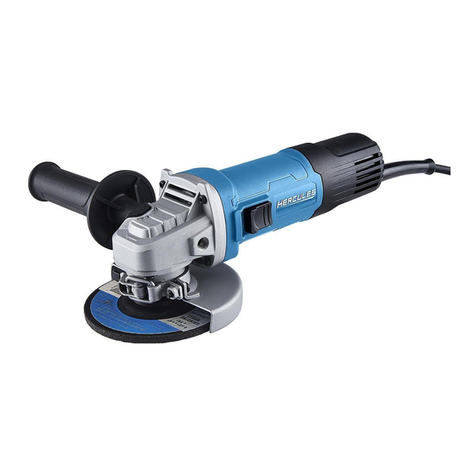
Hercules
Hercules HE61S Assembly instructions
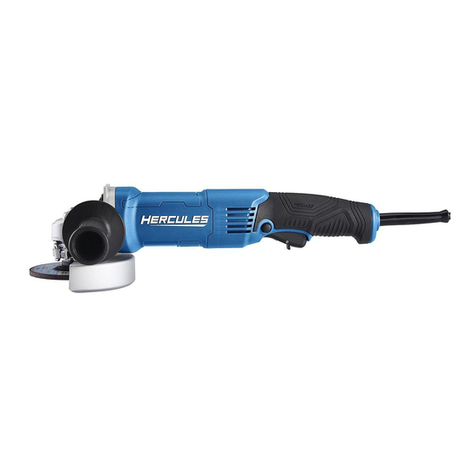
Hercules
Hercules HE65 Assembly instructions

